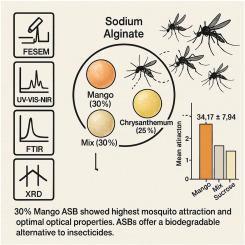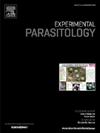不同海藻酸钠诱导糖饵对埃及伊蚊的配制及试验研究。
IF 1.6
4区 医学
Q3 PARASITOLOGY
引用次数: 0
摘要
对于经常与开花植物相互作用以获取糖分的两性蚊子来说,食糖是必不可少的。海藻酸盐糖饵由海藻酸钠(ALG)组成,它是一种安全、天然、可生物降解的聚合物。海藻酸盐糖饵注入糖变体,使其成为有吸引力的糖饵(asb),作为一种长期有效的手段,以增强对蚊子的吸引力。然而,在了解asb的特性和蚊子对其的吸引力方面存在根本性的差距,限制了这种诱饵技术的使用效果。采用芒果30% v/v、菊花25% v/v、混合30% v/v、蔗糖30% v/v的抗菌素对埃及伊蚊进行非选择试验和选择试验,验证抗菌素作为潜在诱蚊工具的有效性。这些配方通过场发射扫描电子显微镜(FESEM)、能量色散x射线(EDX)、紫外-可见-近红外光谱(UV-VIS-NIR)、傅里叶变换红外光谱(FTIR)和x射线衍射(XRD)分析进行评估。结果表明,30%芒果ASB诱蚊率最高,平均诱蚊率为(34.17±7.94),最佳反射率为8%,吸光度为3.1单位。这些asb被推荐为极有前途的驱避杀虫剂替代品,作为吸引蚊子的诱饵工具。本文章由计算机程序翻译,如有差异,请以英文原文为准。

Formulation and testing of different infused attractive sugar baits (ASBs) in sodium alginate against laboratory strain Aedes aegypti
Sugar-feeding is essential to mosquitoes with both sexes that often interacting with flowering plants to acquire sugar. Alginate Sugar Baits are made up of sodium alginate (ALG) which is a safe, natural, and biodegradable polymer. The Alginate Sugar Baits are infused with sugar variants making them Attractive Sugar Baits (ASBs) as a means of providing long-term efficacy to enhance mosquito attraction. However, fundamental gaps in understanding the characteristics of ASBs and the attraction of mosquitoes towards it limits the efficacy of utilizing such bait technology. Testing of non-choice and choice assay of different group of ASBs towards Aedes aegypti to demonstrate the effectiveness of ASBs as a potential baiting tool was performed using 30 % v/v of mango, 25 % v/v of Chrysanthemum, 30 % v/v of mix and sucrose ASBs. These formulations assessed using Field Emission Scanning Electron Microscope (FESEM), Energy Dispersive X-ray (EDX), Ultraviolet–Visible-Near Infrared Spectroscopy (UV–VIS–NIR), Fourier Transform Infrared Spectroscopy (FTIR) and X-ray Diffraction (XRD) analysis. Results indicated that the 30 % mango ASB achieved the highest mosquito attraction, with a mean attraction of (34.17 ± 7.94), optimal reflectance (8 %) and absorbance (3.1 units). These ASBs are recommended as highly promising candidates as an alternative for repellent insecticides, serving as baiting tools for mosquito attraction.
求助全文
通过发布文献求助,成功后即可免费获取论文全文。
去求助
来源期刊

Experimental parasitology
医学-寄生虫学
CiteScore
3.10
自引率
4.80%
发文量
160
审稿时长
3 months
期刊介绍:
Experimental Parasitology emphasizes modern approaches to parasitology, including molecular biology and immunology. The journal features original research papers on the physiological, metabolic, immunologic, biochemical, nutritional, and chemotherapeutic aspects of parasites and host-parasite relationships.
 求助内容:
求助内容: 应助结果提醒方式:
应助结果提醒方式:


